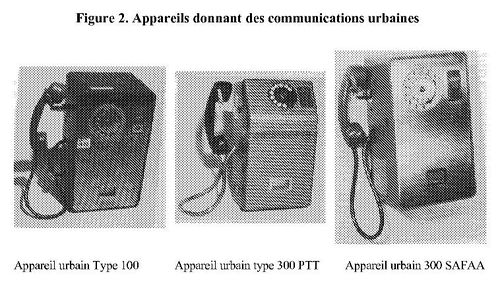France Telephone tokens
General introduction
On the occasion of the Paris World Expo of 1878, France opened its first telephone network, controlled by the brand new Ministry of Post and Telegraph - a merger of the directorate of Post of the ministry of Finance and the directorate of Telegraph of the ministry of Domestic Affairs. The ministry accorded a license to build networks to three companies, merged into the Société Générale des Téléphones - General Telephone Company - in 1880, as the networks expanded outside the big cities. In 1881, the first public phone booth was installed. The first telephone booths were made of oak, upholstered with moleskin, and fitted with adjustable armrests upholstered in velvet. The state opened its first commercial network in 1883 and in 1884, the first inter-city lines were opened. In 1886, a line to Brussels made the first international calls possible. The Société Générale des Téléphones was nationalised in 1889, giving the Ministry of Post and Telegraph a monopoly. This turned out a recipe for stagnation, conservatism and high prices.
Experiments with a telephone exchange started in 1902, the first working automatic telephone exchange was installed only in 1928, in Paris. In 1930, the Ministry of Post and Telegraph finally obtained its own budget. It was only in 1925 that the responsible ministry changed its name to Ministry of Posts, Telegraphs and Telephones (PTT), acknowledging at last the importance of telephone. Though the name was changed again to Ministry of Posts and Telecommunications, it kept the designation PTT. As the national network grew, its infrastructure became more burdensome and technically outdated, resulting in increasing failure to connect. An application for a new telephone number could take years, so that telephone numbers were bought and sold at a hefty premium. This situation explains the popularity of telephone booths. High inflation made tokens for the booths efficient. Le Taxiphone and Teletax were two phone booth producers that issued tokens.
From 1974, a number of technical reforms and the introduction of electronics gave France the opportunity to catch up. In 1988, France Telecom took over the responsibility for the telephone network, under pressure to privatise from the EU. France Telecom rapidly developed from state monopoly to a private enterprise without a monopoly. In 2004, the state became a minority shareholder. The company was renamed several times and is now known as Orange.
Introduction of the tokens
The first French public telephone was the type Ader. It did not have a payment facility. The Aders were installed in post offices. Clients would request a connection at a window. When a telephone became available, the gestionnaire would assign a client to the telephone and establish the communication. After the time agreed on, there would be a communication of gestures between the client and the gestionnaire with the possibility, but not the guarantee, that the connection would be extended in time. After the call, the client would pay at the window.
Obviously, the system was not very precise, labour intensive and available only during post office opening hours. A test with unsupervised payment failed miserably. However, in 1923, a British engineer, W.F. Hall, invented an extension to the telephone that would make pre-payment possible and close the line when the caller had no more credit. A French engineer, Rousotte integrated the two machines and added the possibility to pay with different coins in 1924. His invention was bought and improved by the company Le Taxiphone. This company acquired a large contract with PTT for the manufacture, maintenance and running of public telephones.
In 1954, a new type of public telephone was introduced: PTT100 Urbain, taking only tokens and good for local calls only. It was quickly succeeded by the type SAFAA100 Urbain, which would weigh the tokens and reject those not within the norm. SA FAA, Société Anonyme Française des Appareils Automatiques, was the new name for Le Taxiphone. As vandals and petty criminals started cracking public telephones, a new model, SAFAA300 Urbain was developed. It was much more resistant to vandalism and theft. These machines bore the brunt of the use of telephone tokens.
Only in 1963 it became possible to place long distance calls in a telephone booth, with the introduction of the SAFAA700 Interurbain, which would take several coins, accept more coins during the call, return unused coins and show how much time or money the client had left. Public phones that could only make local calls quickly disappeared, spelling the end of the telephone token. In 1970, as the telephone system was renewed, SA FAA lost its monopoly on building and running public telephones. From 1980, coin operated public telephones were replaced with types accepting only magnetic telephone cards. This equipment became obsolescent in turn with the rise of the mobile phone.
Telephone token issuers
France
French influence
References
We have made much use of A catalog of telephone and telegraph tokens of the world by H.A. Groenendijk, 2nd edition, 2001, adding our own research. The book is available from World of Coins For technical background, we used Une approche sociotechnique de l'histoire du téléphone public by Fanny Carmagnat, ISSN 0751-7971, available online. The picture is sourced from this paper. There are more details and larger photos in colour here.
Redwine, malj1 and maxmissy did research on Teletax on World of Coins
Redwine, malj1 and others discussed Taxiphone tokens on World of Coins
